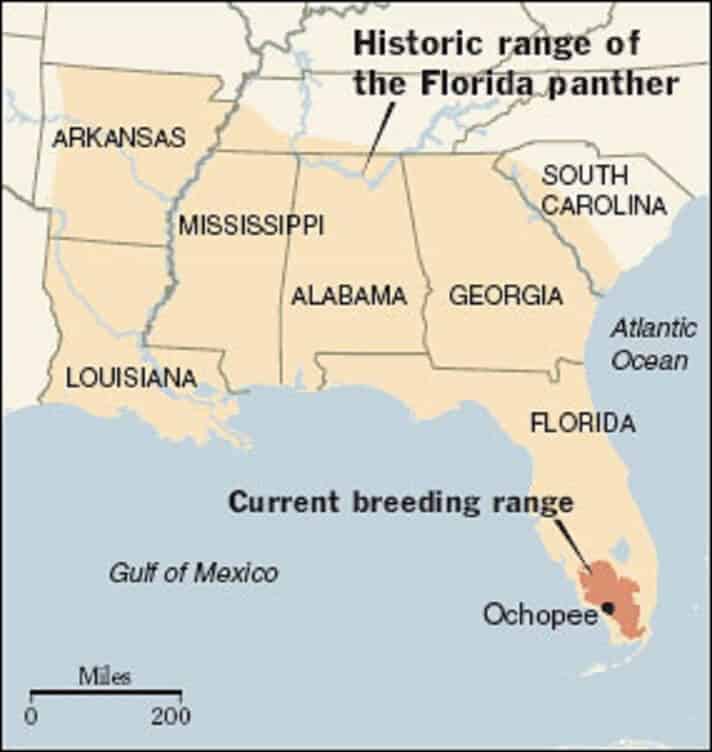New
3 Interesting Facts About the Florida Panther
The Florida panther (Puma concolor coryi) is a subspecies of cougar found only in the state of Florida. It is one of the most endangered mammals in the United States, with a population of only around 230 individuals. The Florida panther is a beautiful and powerful animal, and it plays an important role in the state’s ecosystem. Despite its significance, many people are not aware of the unique characteristics and challenges faced by this majestic creature. In this article, we will explore three interesting facts about the Florida panther that will give you a deeper understanding of this endangered species.
The Only Subspecies of Cougar in the Eastern United States

The Florida panther is a unique subspecies of cougar, and it is the only one that is found in the eastern United States. It is believed that the Florida panther evolved from a population of cougars that migrated from the western United States during the last ice age. This migration was possible due to the land bridge that connected North America to South America at the time. As the climate changed and the land bridge disappeared, the Florida panther became isolated in the state of Florida.
Physical Characteristics
One of the most distinctive features of the Florida panther is its tawny coat with dark spots. This coloration helps them blend in with their surroundings, making them less visible to potential prey. The Florida panther is also smaller than other subspecies of cougar, with males weighing between 100-160 pounds and females weighing between 60-100 pounds. This size difference is due to the limited gene pool of the Florida panther, which has resulted in a decrease in genetic diversity and physical size.
Habitat and Range
The Florida panther’s habitat consists of dense, wooded areas with access to water sources. They can be found in various habitats such as swamps, forests, and prairies. However, their range has significantly decreased over the years due to human development and habitat fragmentation. In the 1800s, Florida panthers could be found throughout the southeastern United States, but now they are only found in a small area of southern Florida.
Conservation Efforts
Due to its limited range and small population size, the Florida panther has been listed as an endangered species since 1967. In the 1970s, the Florida panther population was estimated to be less than 30 individuals, making it one of the most critically endangered mammals in the world. However, thanks to conservation efforts such as captive breeding programs and habitat protection, the population has slowly increased to around 230 individuals today.
Table 1: Florida Panther Population Numbers (1982-2020)
| Year | Estimated Population |
|---|---|
| 1982 | 20-30 |
| 1995 | 50-70 |
| 2003 | 87-107 |
| 2010 | 100-160 |
| 2015 | 120-230 |
| 2020 | 230 |
An Apex Predator at the Top of the Food Chain

The Florida panther is an apex predator, which means that it is at the top of the food chain. This status is crucial for maintaining the balance of the ecosystem in which it lives. As an apex predator, the Florida panther plays a vital role in regulating the populations of its prey species. Without this regulation, there could be an overabundance of certain animals, leading to negative impacts on the environment.
Diet and Hunting Behavior
The Florida panther’s diet consists mainly of white-tailed deer, but they also prey on other animals such as wild hogs, raccoons, and armadillos. They are solitary hunters and typically hunt at night, using their excellent eyesight and hearing to locate prey. The Florida panther is a skilled predator, able to take down prey that is much larger than itself. They use their powerful jaws and sharp claws to bring down their prey quickly.
Threats to Survival
Despite being an apex predator, the Florida panther still faces threats to its survival. One of the main threats is habitat loss and fragmentation due to human development. This loss of habitat not only limits the panther’s range but also reduces the availability of prey. As a result, panthers may have to travel longer distances in search of food, increasing their risk of being hit by vehicles or getting into conflicts with humans.
Another significant threat to the Florida panther is genetic diversity. With such a small population size, there is a high risk of inbreeding, which can lead to health issues and reduced reproductive success. To combat this, conservation efforts have focused on introducing genetic diversity through captive breeding programs and translocation of individuals from other populations.
List 1: Threats to the Florida Panther
- Habitat loss and fragmentation
- Vehicle collisions
- Human-wildlife conflicts
- Inbreeding and genetic diversity
- Disease outbreaks
A Threatened Species in Need of Continued Protection

The Florida panther is a threatened species, and it is one of the most endangered mammals in the United States. Despite conservation efforts, the population remains small and vulnerable to various threats. It is essential to continue protecting and preserving this iconic animal for future generations to enjoy.
Importance in the Ecosystem
As an apex predator, the Florida panther plays a crucial role in maintaining the balance of the ecosystem. By regulating the populations of its prey, it helps prevent overgrazing and maintains healthy vegetation. This, in turn, benefits other species that rely on these plants for food and shelter. The Florida panther also helps control the population of smaller predators, preventing them from becoming too abundant and disrupting the ecosystem.
Economic Impact
The Florida panther also has a significant economic impact on the state. As a top predator, it helps control the populations of animals that could cause damage to crops and livestock. It also brings in ecotourism revenue, with people traveling to Florida to catch a glimpse of this elusive creature. According to a study by the University of Florida, the estimated annual economic impact of the Florida panther is $178 million.
Continued Conservation Efforts
To ensure the survival of the Florida panther, continued conservation efforts are crucial. This includes protecting and preserving their habitat, reducing human-wildlife conflicts, and maintaining genetic diversity. The Florida Fish and Wildlife Conservation Commission (FWC) leads these efforts, working closely with other organizations and agencies to monitor the population and implement conservation strategies.
Conclusion
The Florida panther is a unique and fascinating subspecies of cougar found only in the state of Florida. Its distinctive physical characteristics, role as an apex predator, and status as a threatened species make it a vital part of the state’s ecosystem. Despite facing numerous challenges, the Florida panther continues to survive and thrive thanks to conservation efforts and increased awareness. By understanding and appreciating the three interesting facts about the Florida panther, we can all contribute to its protection and preservation for future generations.
